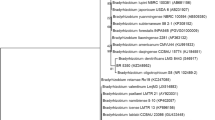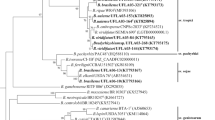Abstract
This study examines mycelial colonization of common soil fungi by bradyrhizobia and an azorhizobial strain, resulting in the forming of biofilms. The effects of the fungal exudates on a bradyrhizobial strain have also been investigated. Bradyrhizobia gradually colonized the mycelia for about 18 days, after which the biofilm structures collapsed with the release of the rhizobial cell clusters to the culture medium. The azorhizobial strain showed differential colonization of the mycelia. In general, there were no considerable mycotoxin effects of the fungal exudates on the bradyrhizobial strain used, instead the rhizobial strain utilized the exudates as a source of nutrition. This study indicates that the present microbial association with biofilm formation has important implications in the survival of rhizobia under adverse soil conditions devoid of vegetation. Further, it could have developed an as yet unidentified nitrogen fixing system that could have contributed to the nitrogen economy of soils.
Similar content being viewed by others
References
Basha S and Ulaganathan K 2002 Antagonism ofBacillus species (strain BC 121) towardsCurvularia lunata;Curr. Sci. 82 1457–1463
Christensen B B, Sternberg C, Anderson J B, Eberl L, Moller S, Givskov M and Molin S 1998 Establishment of new genetic traits in a microbial biofilm community;Appl. Environ. Microbiol. 64 2247–2255
Collins C H, Lyne P M and Grange J M 1989Collins and Lyne’s microbial methods 6th edition (London: Butterworths) p. 95
Davey M E and O’toole G A 2000 Microbial biofilms: from ecology to molecular genetics;Microbiol. Mol. Biol. Rev. 64 847–867
Edwards K J, Bond P L, Gihring T M and Banfield J F 2000 An archael ion-oxidizing extreme acidophile important in acid mine drainage;Science 287 1796–1799
Garbaye J 1994 Helper bacteria: a new dimension to the mycorrhizal symbiosis;New Phytol. 128 197–210
Jones M V 1995 Fungal biofilms: eradication of a common problem; inThe life and death of a biofilm (eds) J W T Wimpenny, P Handley, P Gilbert and Lappin Scott (Cardiff: Bioline) pp 157–160
Mezzalamaa M, Ghinia R, Ruffaa P, Ambrosolia R and Garibaldia A 1998 Effects of antagonisticFusarium oxysporium on functional groups of indigenous bacteria in soil;Appl. Soil. Ecol. 731-40
Morris C E, Monier J and Jacques M 1997 Methods for observing microbial biofilms directly on leaf surfaces and recovering them for isolation of culturable microorganisms;Appl. Envir. Microbiol. 63 1570–1576
O’toole G, Kaplan H B and Kolter R 2000 Biofilm formation as microbial development;Annu. Rev. Microbiol. 54 49–79
Perotto S, Bianciotto V, Balestrini R, Corazza C and Bonfante P 1998 Physical interactions of bacterial biofertilizers and biopesticides with arbuscular mycorrhizal fungi; (http://www-icom2.slu.se/ABSTRACTS/Perotto.html)
Rice W A, Olsen P E and Leggett M E 1995 Co-culture ofRhizobium meliloti and a phosphorus-solubilizing fungus (Penicillium bilaii) in sterile peat;Soil Biol. Biochem. 27 703–705
Xavier L J C and Germida J J 2002 Response of lentil under controlled conditions to co-inoculation with arbascular mycorrhizal fungi and rhizobia varying in efficacy;Soil Biol. Biochem. 34 181–188
Author information
Authors and Affiliations
Rights and permissions
About this article
Cite this article
Seneviratne, G., Jayasinghearachchi, H.S. Mycelial colonization by bradyrhizobia and azorhizobia. J Biosci 28, 243–247 (2003). https://doi.org/10.1007/BF02706224
Received:
Accepted:
Issue Date:
DOI: https://doi.org/10.1007/BF02706224




